FIND COMPOSITION OF TWO FUNCTIONS
Subscribe to our ▶️ YouTube channel 🔴 for the latest videos, updates, and tips.
Definition :
Let f : A ----> B and g : B ----> C be two functions. Then the composition of f and g denoted by g o f is defined as the function g o f(x) = g[f(x)] for all x ∈ A.
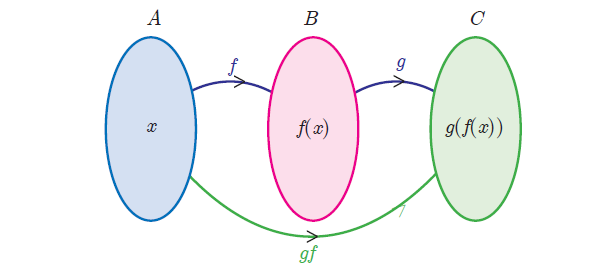
Note :
Generally, f o g ≠ g o f for any two functions f and g. So, composition of functions is not commutative.
Example 1 :
Find f o g, if f(x) = x and g(x) = 3x2.
Solution :
f o g = f[g(x)]
= f[3x2]
= 3x2
Example 2 :
If f(x) = 2x - 5 and g(x) = x + 2 find f o g.
Solution :
f o g = f[g(x)]
= f[x + 2]
= 2(x + 2) - 5
= 2x + 4 - 5
= 2x - 1
Example 3 :
If f(x) = -3x + 4 and g(x) = x2 find g o f.
Solution :
g o f = g[f(x)]
= g[-3x + 4]
= (-3x + 4)2
= (-3x)2 + 2(-3x)(4) + 42
= 9x2 - 24x + 16
Example 4 :
If f(x) = 4x2 + 2 and g(x) = √(x- 8) find f o g.
Solution :
f o g = f[g(x)]
= f[√(x- 8)]
= 4[√(x- 8)]2 + 2
= 4(x- 8) + 2
= 4x - 32 + 2
= 4x - 30
Example 5 :
If f(x) = -9x + 4 and g(x) = x4, find g o f.
Solution :
g o f = g[f(x)]
= g[-9x + 4]
= (-9x + 4)4
Example 6 :
If f(x) = 2x + 1 and g(x) = x2 - 2, then verify f o g = g o f.
Solution :
f o g :
= f[g(x)]
= f[x2 - 2]
= 2(x2 - 2) + 1
= 2x2 - 4 + 1
= 2x2 - 3 ----(1)
g o f :
= g[f(x)]
= g[2x + 1]
= (2x + 1)2 - 2
= (2x)2 + 2(2x)(1) + 12 - 2
= 4x2 4x + 1 - 2
= 4x2 4x - 1 ----(2)
From (1) and (2), we see that f o g ≠ g o f.
Example 7 :
Let f(x) = 2x and g(x) = x3 - 4x. Find the following.
a) f(g(2)) b) (g o f)(-1) c) g(f(1))
Solution :
Given that f(x) = 2x and g(x) = x3 - 4x
a) f(g(2))
g(2) = 23 - 4(2)
= 8 - 8
g(2) = 0
Applying the value of g(2) in f(g(2))
f(g(2)) = f(0)
To evaluate f(0), we have to apply x = 0 in the function f(x).
f(0) = 20
= 1
So, the value of f(g(2)) is 1.
b) (g o f)(-1) = g[f(-1)]
Applying -1 for x in the function f(x), we get
f(-1) = 2-1
= 1/2
Applying the value of f(-1) in g[f(-1)], we get
= g(1/2)
To evaluate g(1/2) in the function g(x)
g(1/2) = (1/2)3 - 4(1/2)
= 1/8 - 2
= (1 - 16)/8
= -15/8
So, the value of (g o f)(-1) is -15/8.
c) g(f(1))
f(1) = 21
= 2
Applying the value of f(1) in g(f(1))
= g(2)
To evaluate g(2), we apply x = 2 in the function g(x).
g(x) = 23 - 4(2)
= 8 - 8
= 0
So, the value of g(f(1)) is 0.
Example 8 :
Let f(x) = 4x and h(x) = f(g(x)). Fill in the table.
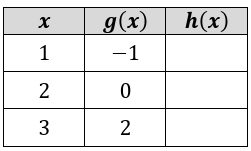
Solution :
When x = 1
h(1) = f(g(1))
From the table, the value of g(1) is -1
h(1) = f(-1)
From f(x) = 4x, we get f(-1) = 4-1
= 1/4
h(1) = 1/4
When x = 2
h(2) = f(g(2))
From the table, the value of g(2) is 0
h(2) = f(0)
From f(x) = 4x, we get f(0) = 40
= 1
h(2) = 1
When x = 3
h(3) = f(g(3))
From the table, the value of g(3) is 2
h(3) = f(2)
From f(x) = 4x, we get f(2) = 4-2
= 1/42
= 1/16
h(3) = 1/16
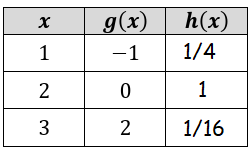
Example 9 :
Let g(x) = √(2x - 1) and h(x) = g(f(x)). Fill in the table.
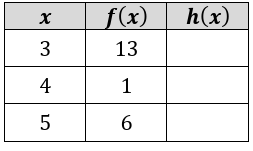
Solution :
g(x) = √(2x - 1) and h(x) = g(f(x))
When x = 3
h(3) = g(f(3))
From the table, the value of f(3) is 13
= g(13)
Evaluating the value of g(13) :
g(13) = √(2(13) - 1)
= √(26 - 1)
= √25
= 5
When x = 4
h(4) = g(f(4))
From the table, the value of f(4) is 1
= g(1)
Evaluating the value of g(1) :
g(1) = √(2(1) - 1)
= √(2 - 1)
= √1
= 1
When x = 5
h(5) = g(f(5))
From the table, the value of f(5) is 6
= g(6)
Evaluating the value of g(6) :
g(6) = √(2(6) - 1)
= √(12 - 1)
= √11
Example 10 :
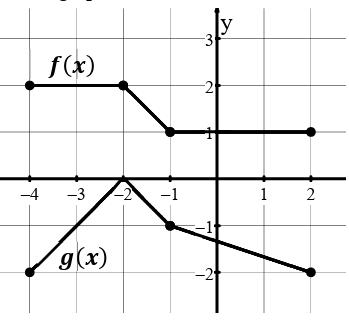
a) Find f(g(2))
b) Find (g o f) (-2)
c) Find g(f(-4))
Solution :
a) f(g(2))
From the graph, the value of g(2). We get the point (2, -2).
f(g(2)) = f(-2)
From the graph f(x), the point is (-2, 2).
f(g(2)) = 2
b) (g o f) (-2) = g(f(-2))
From the graph f(x), we get the point (-2, 2).
= g(2)
From the graph of g(x), we get the point (2, -2).
g(2) = -2
So, the value of (g o f) (-2) is -2.
c) g(f(-4))
From the graph of f(x), we get the point (-4, 2).
f(-4) = 2
g(f(-4)) = g(2)
From the graph of g(x), we get the point (2, -2).
So, the value of g(f(-4)) is -2.
Subscribe to our ▶️ YouTube channel 🔴 for the latest videos, updates, and tips.
Kindly mail your feedback to v4formath@gmail.com
We always appreciate your feedback.
About Us | Contact Us | Privacy Policy
©All rights reserved. onlinemath4all.com

Recent Articles
-
GMAT Quantitative Reasoning Questions and Answers
Dec 27, 25 09:33 PM
GMAT Quantitative Reasoning Questions and Answers -
10 Hard SAT Math Questions (Part - 40)
Dec 25, 25 08:30 AM
10 Hard SAT Math Questions (Part - 40) -
10 Hard SAT Math Questions (Part - 41)
Dec 24, 25 07:58 PM
10 Hard SAT Math Questions (Part - 41)

